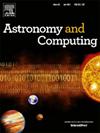Nessie:一个用R和Python编写的、由rust驱动的、快速的、灵活的、广义的朋友的朋友星系群查找器
IF 1.8
4区 物理与天体物理
Q2 ASTRONOMY & ASTROPHYSICS
引用次数: 0
摘要
我们介绍Nessie,一个用Rust实现的星系群查找器,并以Python和R包的形式发布。尼斯采用朋友的朋友(FoF)算法,只需要天空位置和红移作为输入,使其立即适用于缺乏明确定义的亮度函数的调查。我们实现了几种算法优化-包括二叉搜索和k-d树预选-通过减少不必要的星系对检查显着提高了性能。为了验证尼斯湖水怪的准确性,我们使用一套GALFORM模拟光锥来调整其参数,并获得了强大的优点图。通过将其应用于GAMA和SDSS调查,我们进一步证明了其可靠性,其中它产生与文献中一致的组目录。还包括用于与模拟和模拟目录进行比较的附加功能。在标准MacBook Pro(11核M3芯片)上进行的基准测试显示,Nessie的版本1可以在10秒内处理100万个星系,突出了它的速度和对下一代红移调查的适用性。本文章由计算机程序翻译,如有差异,请以英文原文为准。
Nessie: A rust-powered, fast, flexible, and generalized friends-of-friends galaxy-group finder in R and Python
We introduce Nessie, a galaxy group finder implemented in Rust and distributed as both a Python and R package. Nessie employs the friends-of-friends (FoF) algorithm and requires only on-sky position and redshift as input, making it immediately applicable to surveys that lack a well-defined luminosity function. We implement several algorithmic optimizations – including binary search and k-d tree pre-selection – that significantly improve performance by reducing unnecessary galaxy pair checks. To validate the accuracy of Nessie, we tune its parameters using a suite of GALFORM mock lightcones and achieve a strong Figure of Merit. We further demonstrate its reliability by applying it to both the GAMA and SDSS surveys, where it produces group catalogues consistent with those in the literature. Additional functionality is included for comparison with simulations and mock catalogues. Benchmarking on a standard MacBook Pro (M3 chip with 11 cores) shows that version 1 of Nessie can process 1 million galaxies in s, highlighting its speed and suitability for next-generation redshift surveys.
求助全文
通过发布文献求助,成功后即可免费获取论文全文。
去求助
来源期刊

Astronomy and Computing
ASTRONOMY & ASTROPHYSICSCOMPUTER SCIENCE,-COMPUTER SCIENCE, INTERDISCIPLINARY APPLICATIONS
CiteScore
4.10
自引率
8.00%
发文量
67
期刊介绍:
Astronomy and Computing is a peer-reviewed journal that focuses on the broad area between astronomy, computer science and information technology. The journal aims to publish the work of scientists and (software) engineers in all aspects of astronomical computing, including the collection, analysis, reduction, visualisation, preservation and dissemination of data, and the development of astronomical software and simulations. The journal covers applications for academic computer science techniques to astronomy, as well as novel applications of information technologies within astronomy.
 求助内容:
求助内容: 应助结果提醒方式:
应助结果提醒方式:


